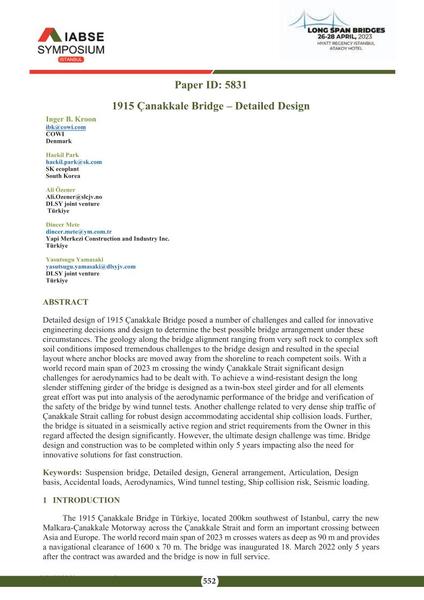1915 Çanakkale Bridge – Detailed Design

|
|
|||||||||||
Bibliographic Details
| Author(s): |
Inger B. Kroon
(COWI, Denmark)
Haekil Park (SK ecoplant, South Korea) Ali Özener (DLSY joint venture Türkiye) Dincer Mete (Yapi Merkezi Construction and Industry Inc. Türkiye) Yasutsugu Yamasaki (DLSY joint venture, Türkiye) |
||||
|---|---|---|---|---|---|
| Medium: | conference paper | ||||
| Language(s): | English | ||||
| Conference: | IABSE Symposium: Long Span Bridges, Istanbul, Turkey, 26-28 April 2023 | ||||
| Published in: | IABSE Symposium Istanbul 2023 | ||||
|
|||||
| Page(s): | 552-559 | ||||
| Total no. of pages: | 8 | ||||
| Year: | 2023 | ||||
| DOI: | 10.2749/istanbul.2023.0552 | ||||
| Abstract: |
Detailed design of 1915 Çanakkale Bridge posed a number of challenges and called for innovative engineering decisions and design to determine the best possible bridge arrangement under these circumstances. The geology along the bridge alignment ranging from very soft rock to complex soft soil conditions imposed tremendous challenges to the bridge design and resulted in the special layout where anchor blocks are moved away from the shoreline to reach competent soils. With a world record main span of 2023 m crossing the windy Çanakkale Strait significant design challenges for aerodynamics had to be dealt with. To achieve a wind-resistant design the long slender stiffening girder of the bridge is designed as a twin-box steel girder and for all elements great effort was put into analysis of the aerodynamic performance of the bridge and verification of the safety of the bridge by wind tunnel tests. Another challenge related to very dense ship traffic of Çanakkale Strait calling for robust design accommodating accidental ship collision loads. Further, the bridge is situated in a seismically active region and strict requirements from the Owner in this regard affected the design significantly. However, the ultimate design challenge was time. Bridge design and construction was to be completed within only 5 years impacting also the need for innovative solutions for fast construction. |
||||
| Keywords: |
suspension bridge detailed design seismic loading aerodynamics general arrangement design basis wind tunnel testing accidental loads articulation Ship collision risk
|
||||
